COETAIL: Teaching the Holocaust and Uncovering Personal Histories in Japan
Another post toward obtaining my Certificate in Educational Technology and Information Literacy (COETAIL)
For a number of years now, I've taught a unit on the Holocaust to my university students in Japan using the simple and beautiful book Hana's Suitcase. Originally I taught this as a study unit integrated into a literature class (as a nonfiction approach to story) but recently, I've taught the topic in a one-week intensive course--i.e. fifteen 90-minute class periods crammed into one week. And, lucky me, I have been able to teach the entire course in the language lab--meaning full access to computers and internet for students and me during each class.

Hana's Suitcase tells the true story of Hana Brady, a Jewish girl growing up in Czechoslovakia during the German occupation. Her story alternates with the story of Fumiko Ishioka, the curator of the Tokyo Holocaust Education Resource Center and her determination to learn more about the girl behind the name painted on a suitcase received for display from the Auschwitz Museum.
In general, students in Japan know little about the Holocaust. They've learned almost nothing about it in school and come into the course with only vague notions of what it was all about. Because the prose in Hana's Suitcase is straightforward, my university EFL students can read it at a fast pace. There are photos. There are documents. They quickly get swept up in the story, and come away inspired by Hana, her brother George, and the indefatigable Fumiko Ishioka.
As one student put it after he finished reading: "Before reading, I thought this is just a miserable story. But it is one side of this book. This story gives us special bravery. More Japanese people should learn this amazing story."
Another student said, "To read the entire book, I learned the importance of paying more attention about not only Japan but also the world and what the past included."
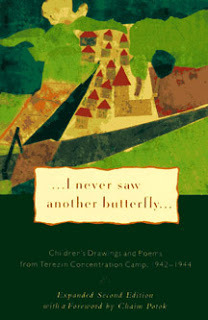 To complement the text, I've created a wiki with links to websites, maps, photos and film clips, audio interviews, and lists of related books and films. In class we view resources, read, discuss and students post comments on the wiki discussion board each day. We read lists of the growing restrictions placed on Jews in Czechoslovakia from 1939-1941. We study maps of the Theresienstadt ghetto, where Hana and her brother were taken. We pore over drawings and paintings created by children in Theresienstadt collected in the book I Never Saw Another Butterfly. These images are incredibly powerful. The pictures, many created under the artistic direction of deported Austrian artist Friedl Dicker-Brandeis using cobbled together art supplies, have enormous emotional impact. Later, one student commented:
To complement the text, I've created a wiki with links to websites, maps, photos and film clips, audio interviews, and lists of related books and films. In class we view resources, read, discuss and students post comments on the wiki discussion board each day. We read lists of the growing restrictions placed on Jews in Czechoslovakia from 1939-1941. We study maps of the Theresienstadt ghetto, where Hana and her brother were taken. We pore over drawings and paintings created by children in Theresienstadt collected in the book I Never Saw Another Butterfly. These images are incredibly powerful. The pictures, many created under the artistic direction of deported Austrian artist Friedl Dicker-Brandeis using cobbled together art supplies, have enormous emotional impact. Later, one student commented:
"Many children drew happy pictures, but some children drew pictures of serious subjects: the ghetto walls, people waiting in line for food, inmates being beaten by Nazi soldiers. How did they feel while drawing these pictures? When I saw these pictures, their sad feelings came down on me."
We also closely examine Hana's drawings and paintings online.
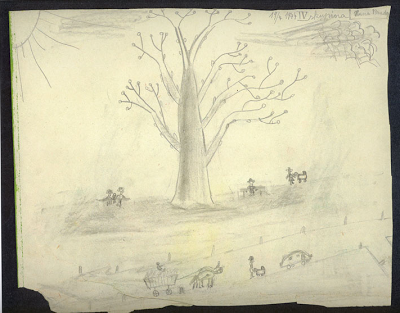 One of Hana's drawings from the Hana's Suitcase website via the Jewish Museum in PragueI also share with students the identification cards I've collected from my visits to the U.S. Holocaust Memorial Museum in Washington, DC.
One of Hana's drawings from the Hana's Suitcase website via the Jewish Museum in PragueI also share with students the identification cards I've collected from my visits to the U.S. Holocaust Memorial Museum in Washington, DC.
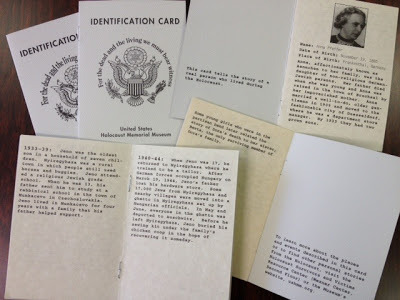
Then we look through the museum's online collection of identitification cards--of individuals who survived and individuals who perished in the Holocaust.
We consider other genocides in history, and current conflicts around the world that might be considered genocide.
I then send my students in a different direction, looking at war experiences of someone they know. I assign a personal history project to create an identification card of a person they can interview who lived through the WWII/Pacific War years--a relative, a family friend, a neighbor or community member. The ID card is to follow the same basic organizational structure as the U.S. Holocaust Memorial Museum ID cards. On the final day, students present to the class the profile of the individual they interviewed.
Doing all this in a one-week course is, well, intensive. My students impress me though, and they are always enthusiastic about the course and the final project. One student said after the recent intensive, "I learned I should know my family's story and I should hand it down to my children. Even though Japan is a very small island country, there are tons of stories about the war time."
Here, with student and family permission, are three personal histories gathered by my university students. (These particular personal histories happen to be all of men, but in my full collection of these histories collected over the years I've been teaching this unit, there are many women as well.)
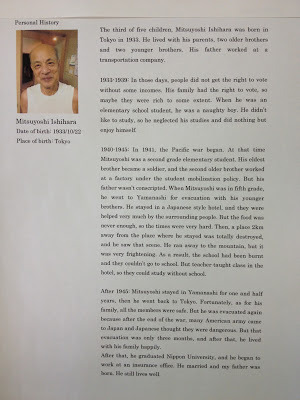

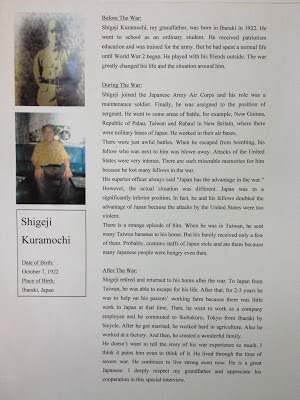
In COETAIL course 3, our current focus is visual literacy, and I am acutely aware of how this study-unit-turned-intensive-course has evolved with technology over the years since I first taught it in 2005, and how my own visual literacy has developed since then. So many primary documents are now viewable online for the Holocaust education portion of the course. Interactive maps are a link away. Photos are easy to click through. Film clips are easy to find and view. And no more stacks of copying for me. My university students are also fairly visually literate. And for the interview part of the course, more elderly Japanese are now online or someone nearby is, able to share current and early photos of themselves and to email them to the interviewer student.
So, wouldn't it be amazing now to have university classrooms all over Japan, even Asia, doing this project? (And wouldn't it be brilliant if I could teach all my classes in rooms with computer and internet access for all students?)
For a number of years now, I've taught a unit on the Holocaust to my university students in Japan using the simple and beautiful book Hana's Suitcase. Originally I taught this as a study unit integrated into a literature class (as a nonfiction approach to story) but recently, I've taught the topic in a one-week intensive course--i.e. fifteen 90-minute class periods crammed into one week. And, lucky me, I have been able to teach the entire course in the language lab--meaning full access to computers and internet for students and me during each class.

Hana's Suitcase tells the true story of Hana Brady, a Jewish girl growing up in Czechoslovakia during the German occupation. Her story alternates with the story of Fumiko Ishioka, the curator of the Tokyo Holocaust Education Resource Center and her determination to learn more about the girl behind the name painted on a suitcase received for display from the Auschwitz Museum.
In general, students in Japan know little about the Holocaust. They've learned almost nothing about it in school and come into the course with only vague notions of what it was all about. Because the prose in Hana's Suitcase is straightforward, my university EFL students can read it at a fast pace. There are photos. There are documents. They quickly get swept up in the story, and come away inspired by Hana, her brother George, and the indefatigable Fumiko Ishioka.
As one student put it after he finished reading: "Before reading, I thought this is just a miserable story. But it is one side of this book. This story gives us special bravery. More Japanese people should learn this amazing story."
Another student said, "To read the entire book, I learned the importance of paying more attention about not only Japan but also the world and what the past included."
 To complement the text, I've created a wiki with links to websites, maps, photos and film clips, audio interviews, and lists of related books and films. In class we view resources, read, discuss and students post comments on the wiki discussion board each day. We read lists of the growing restrictions placed on Jews in Czechoslovakia from 1939-1941. We study maps of the Theresienstadt ghetto, where Hana and her brother were taken. We pore over drawings and paintings created by children in Theresienstadt collected in the book I Never Saw Another Butterfly. These images are incredibly powerful. The pictures, many created under the artistic direction of deported Austrian artist Friedl Dicker-Brandeis using cobbled together art supplies, have enormous emotional impact. Later, one student commented:
To complement the text, I've created a wiki with links to websites, maps, photos and film clips, audio interviews, and lists of related books and films. In class we view resources, read, discuss and students post comments on the wiki discussion board each day. We read lists of the growing restrictions placed on Jews in Czechoslovakia from 1939-1941. We study maps of the Theresienstadt ghetto, where Hana and her brother were taken. We pore over drawings and paintings created by children in Theresienstadt collected in the book I Never Saw Another Butterfly. These images are incredibly powerful. The pictures, many created under the artistic direction of deported Austrian artist Friedl Dicker-Brandeis using cobbled together art supplies, have enormous emotional impact. Later, one student commented: "Many children drew happy pictures, but some children drew pictures of serious subjects: the ghetto walls, people waiting in line for food, inmates being beaten by Nazi soldiers. How did they feel while drawing these pictures? When I saw these pictures, their sad feelings came down on me."
We also closely examine Hana's drawings and paintings online.
 One of Hana's drawings from the Hana's Suitcase website via the Jewish Museum in PragueI also share with students the identification cards I've collected from my visits to the U.S. Holocaust Memorial Museum in Washington, DC.
One of Hana's drawings from the Hana's Suitcase website via the Jewish Museum in PragueI also share with students the identification cards I've collected from my visits to the U.S. Holocaust Memorial Museum in Washington, DC.
Then we look through the museum's online collection of identitification cards--of individuals who survived and individuals who perished in the Holocaust.
We consider other genocides in history, and current conflicts around the world that might be considered genocide.
I then send my students in a different direction, looking at war experiences of someone they know. I assign a personal history project to create an identification card of a person they can interview who lived through the WWII/Pacific War years--a relative, a family friend, a neighbor or community member. The ID card is to follow the same basic organizational structure as the U.S. Holocaust Memorial Museum ID cards. On the final day, students present to the class the profile of the individual they interviewed.
Doing all this in a one-week course is, well, intensive. My students impress me though, and they are always enthusiastic about the course and the final project. One student said after the recent intensive, "I learned I should know my family's story and I should hand it down to my children. Even though Japan is a very small island country, there are tons of stories about the war time."
Here, with student and family permission, are three personal histories gathered by my university students. (These particular personal histories happen to be all of men, but in my full collection of these histories collected over the years I've been teaching this unit, there are many women as well.)



In COETAIL course 3, our current focus is visual literacy, and I am acutely aware of how this study-unit-turned-intensive-course has evolved with technology over the years since I first taught it in 2005, and how my own visual literacy has developed since then. So many primary documents are now viewable online for the Holocaust education portion of the course. Interactive maps are a link away. Photos are easy to click through. Film clips are easy to find and view. And no more stacks of copying for me. My university students are also fairly visually literate. And for the interview part of the course, more elderly Japanese are now online or someone nearby is, able to share current and early photos of themselves and to email them to the interviewer student.
So, wouldn't it be amazing now to have university classrooms all over Japan, even Asia, doing this project? (And wouldn't it be brilliant if I could teach all my classes in rooms with computer and internet access for all students?)
Published on September 18, 2013 00:07
No comments have been added yet.



